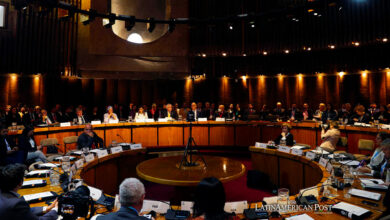USA and China: closer to a trade agreement
On January 15, the United States and China will sign the first phase of a trade agreement that could end the tensions of both countries.

President of the United States, Donald Trump, and President of China, Xi Jinping. / Photo: Reuters
LatinAmerican Post | Juliana Suárez
Listen to this article
Leer en español: EE.UU y China: más cerca de un acuerdo comercial
The agreement had been announced earlier in December and seeks that the two largest economies in the world are aligned in what would mean a worldwide macroeconomic improvement.
The ceremony, said President Trump, will be held in the White House and will feature some Chinese figures, although President Xi Jinping will not be present, although he had initially said that he would be .
I will be signing our very large and comprehensive Phase One Trade Deal with China on January 15. The ceremony will take place at the White House. High level representatives of China will be present. At a later date I will be going to Beijing where talks will begin on Phase Two!
— Donald J. Trump (@realDonaldTrump) December 31, 2019
This agreement came after an approach was announced in October between the two Nations, who had been in a commercial war for months that had affected many sectors such as automotive and construction, among others. The commercial dispute had led both countries to make decisions to block products of the other nation, also imposing tariffs on some materials such as steel and aluminum.
The commercial war affected the world economy during 2018 and 2019, creating distrust in investments and the economy in general, as these are the two largest economic powers in the world. According to El Tiempo, the International Monetary Fund (IMF) published in October a 3% reduction in expansion projections, which meant two points less than the July report. This being the case, not only the economy of both Nations, but the whole world depended on the progress that these discussions could have.
Also read: 10 years and 10 facts in Latin America
The process, however, has been permeated by strong tensions between the two Nations, whose managers have shared different information in some cases, and have criticized the opposing nation for not being willing or seeking to take advantage of the negotiation.
A first phase
The first phase of the agreement includes points such as intellectual property, technology transfer, trade expansion and mechanisms so that there is an optimal resolution of conflicts in the future.
Although tariffs will continue, this first phase includes the willingness to begin to reduce them progressively. This “includes the partial withdrawal of the levies and the increase in Chinese purchases of national products,” said El Tiempo.
The agreement is ready and translated from days ago, for which US Treasury Minister Steven Mnuchin said he was undergoing a final technical review. According to El Sol de México, "The United States would agree to reduce some tariffs in exchange for a big jump in Chinese purchases of US agricultural products." This in order to achieve growth in the US economy and prevent the global economy from continuing to stagnate.
Also read: Luxury consumption can fuel 'impostor syndrome' among some buyers
After the January 15 ceremony, President Trump and his team will travel to China to meet this time with Xi Jinping and the rest of the team to advance a second phase.
In this second phase, the tariff reductions of some products will be discussed, such as tariffs of 25 percent for imported Chinese products for 250,000 million dollars. Meanwhile, this and other tariffs will continue.





